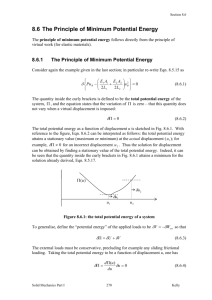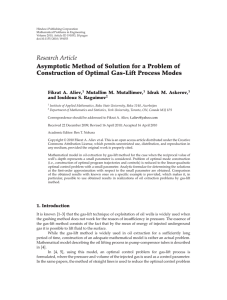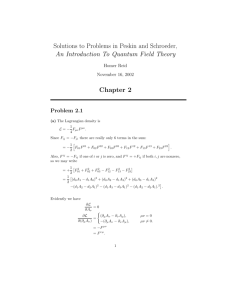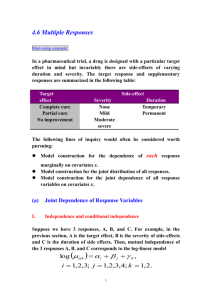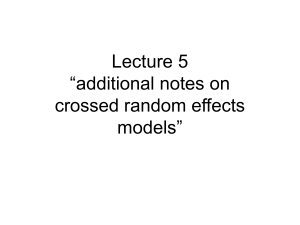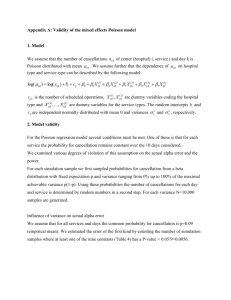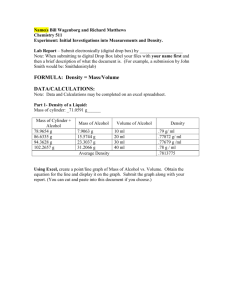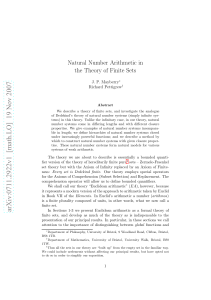Physics 217. Quantum Field Theory. Professor Dine Fall
advertisement
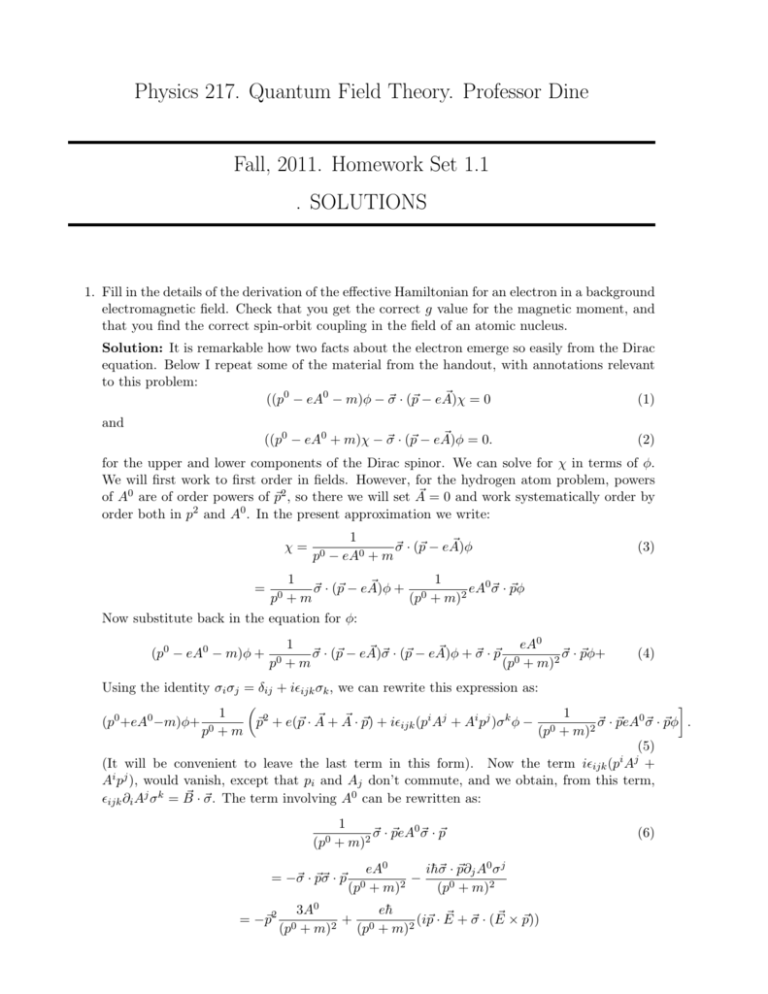
Physics 217. Quantum Field Theory. Professor Dine Fall, 2011. Homework Set 1.1 . SOLUTIONS 1. Fill in the details of the derivation of the effective Hamiltonian for an electron in a background electromagnetic field. Check that you get the correct g value for the magnetic moment, and that you find the correct spin-orbit coupling in the field of an atomic nucleus. Solution: It is remarkable how two facts about the electron emerge so easily from the Dirac equation. Below I repeat some of the material from the handout, with annotations relevant to this problem: ~ =0 ((p0 − eA0 − m)φ − ~σ · (~ p − eA)χ (1) and ~ = 0. ((p0 − eA0 + m)χ − ~σ · (~ p − eA)φ (2) for the upper and lower components of the Dirac spinor. We can solve for χ in terms of φ. We will first work to first order in fields. However, for the hydrogen atom problem, powers ~ = 0 and work systematically order by of A0 are of order powers of p~2 , so there we will set A 2 0 order both in p and A . In the present approximation we write: χ= = p0 p0 1 ~ ~σ · (~ p − eA)φ − eA0 + m (3) 1 1 ~ + ~σ · (~ p − eA)φ eA0~σ · p~φ 0 +m (p + m)2 Now substitute back in the equation for φ: (p0 − eA0 − m)φ + 0 1 ~ σ · (~ ~ + ~σ · p~ eA ~ σ · (~ p − e A)~ p − e A)φ ~σ · p~φ+ p0 + m (p0 + m)2 (4) Using the identity σi σj = δij + iijk σk , we can rewrite this expression as: 1 1 ~+A ~ · p~) + iijk (pi Aj + Ai pj )σ k φ − p~2 + e(~ p·A ~σ · p~eA0~σ · p~φ . 0 0 p +m (p + m)2 (5) i j (It will be convenient to leave the last term in this form). Now the term iijk (p A + Ai pj ), would vanish, except that pi and Aj don’t commute, and we obtain, from this term, ~ · ~σ . The term involving A0 can be rewritten as: ijk ∂i Aj σ k = B (p0 +eA0 −m)φ+ 1 ~σ · p~eA0~σ · p~ (p0 + m)2 = −~σ · p~~σ · p~ = −~ p2 (p0 eA0 ih̄~σ · p~∂j A0 σ j − 2 + m) (p0 + m)2 3A0 eh̄ ~ + ~σ · (E ~ × p~)) + (i~ p·E (p0 + m)2 (p0 + m)2 (6) 2. Peskin 2.1. Solution: a. It is convenient to rewrite: 1 L = − F µν ∂µ Aν 2 µν where we have used the antisymmetry of F . So differentiating ∂µ Aν gives (7) ∂µ F µν = 0. (8) (Note the symmetries among indices; differentiating the F µν term gives the same result; in particular, if the lagrangian includes Aµ jµ , we obtain ∂µ F µν = j ν .) b. The “naive” stress tensor is: Tνµ = ∂L ∂ν Aρ − Lδνµ ∂(∂µ Aρ ) (9) 1 2 µ δν . = −F µρ ∂ν Aρ + Fµν 4 In the second line, we have used the Lagrangian in the form of eqn. 1, and noted that differentiating the F term gives the same result as the ∂A term (thus accounting for a factor of 2). Now if we add ∂λ K λµν , we obtain an object which is conserved, if we differentiate ∂µ , since ∂µ ∂λ K λµν = 0. (10) In particular, we can take K λµν = F µλ Aν . Then the term we add to Tνµ is ∂λ (F µλ Aν ) = f µλ ∂λ Aν + ∂λ F µλ Aν . (11) The second term vanishes by the equations of motion. Rewriting the first term (just relabeling the indices) as F µρ ∂ρ Aν , we have 2 µ Tνµ = F µρ Fρν + 1 over4Fρσ δν . (12) For example, 1 ~2 ~2 T00 = F 0i Fi0 − (E −B ) 2 1 ~2 ~2 = (E + B ). 2 (13) 3. Peskin 2.2. Solution: a) Conjugate momenta: Π = φ̇∗ Π∗ = φ̇. Hamiltonian is constructed as usual. Heisenberg equation of motion for φ follows almost by inspection from [φ(~x, t), Π(~x0 , t)] = iδ(~x − ~x0 )l: iφ̇(~x, t) = [H, φ(~x, t)] = iΠ∗ . Z iΠ̇(~x, t) = [H, Π(~x, t)] = (14) ~ 2 φ∗ (~x0 , t)φ(~x0 , t) + m2 φ2 φ(~x0 t) ] d3 x0 [Π(~x, t), −∇ (15) where in the gradient term we have integrated by parts to get this into a convenient form. Evaluating the commutator: Z ~ 2 φ∗ (~x0 , t) + m2 φ∗ . d3 x0 iδ(~x − ~x0 ) −∇ iΠ̇(~x, t) = [H, Π(~x, t)] = (16) With Π = iφ̇∗ , this is the Klein-Gordan equation for φ∗ . b) Because φ is complex, we have to treat the field and its complex conjugate separately. As we have encountered for the Dirac field, we have Z φ(~x, t) = φ∗ (~x, t) = 1 d3 p p a(~ p)e−ip·x + b† (p)ei·x 3 (2π) 2E(p) (17) d3 p 1 † ip·x −i·x p a (~ p )e + b(p)e (2π)3 2E(p) (18) Z The Hamiltonian is: Z H= d3 p † † a (~ p )a(~ p ) + b (~ p )b(~ p ) ω(~ p) (2π)3 (19) up to a normal ordering constant. c) We first need to understand the conserved current. The lagrangian is symmetric under φ → eiα φ. Taking α infinitesimal, and a function of x, we can implement the usual Noether procedure: δL = i∂µ α(∂ µ φ∗ φ − φ∗ ∂ µ φ) (20) so that the conserved current is the coefficient of ∂ µ α: j µ = i(∂ µ φ∗ φ − φ∗ ∂ µ φ). (21) The charge is the integral of j 0 . This is Z Q= d3 xi(Πφ − φ∗ Π) (22) This differs by a sign and a factor of two from Peskin and Schroeder, but this can be absorbed into the definition of the current (the current is still conserved); it corresponds to making the replacement α → −α/2. Plugging in our mode expansion above, gives, not surprisingly: 1 Q= 2 Z d3 p † † a (~ p )a(~ p ) − b (~ p )b(~ p ) (2π)3 corresponding to particles of charge 1/2, anti-particles of charge −1/2. d) This is a simple exercise with the commutation relations. (23)
